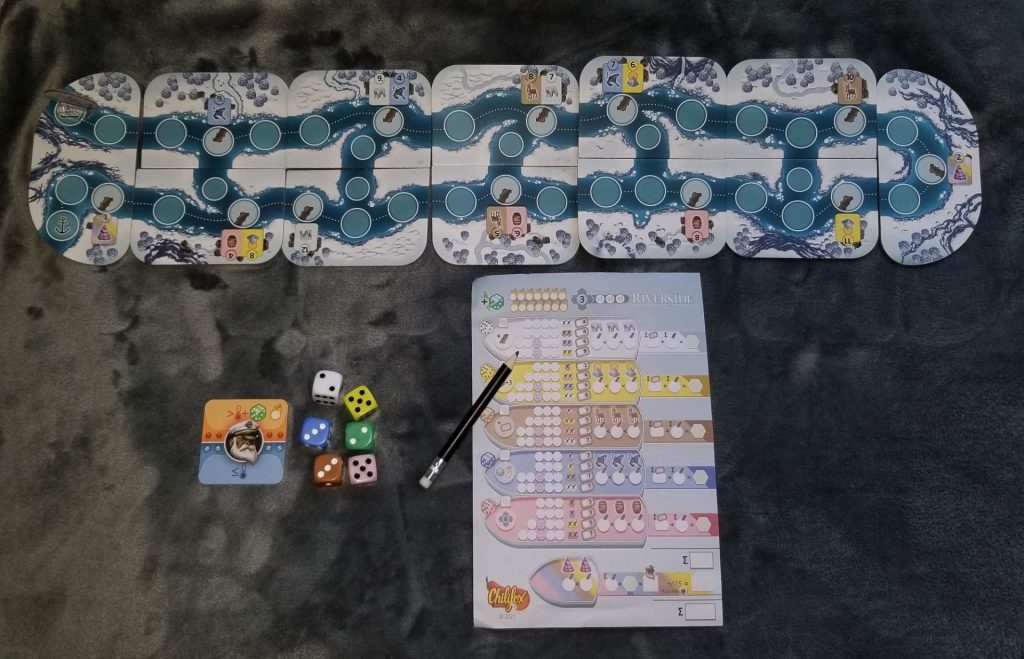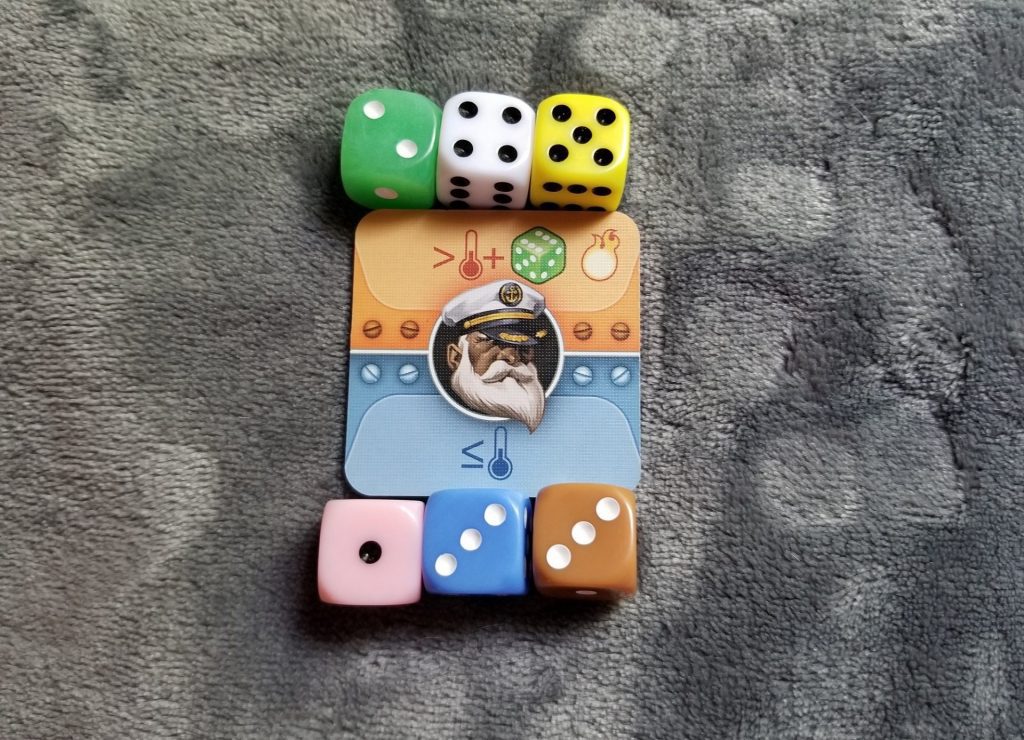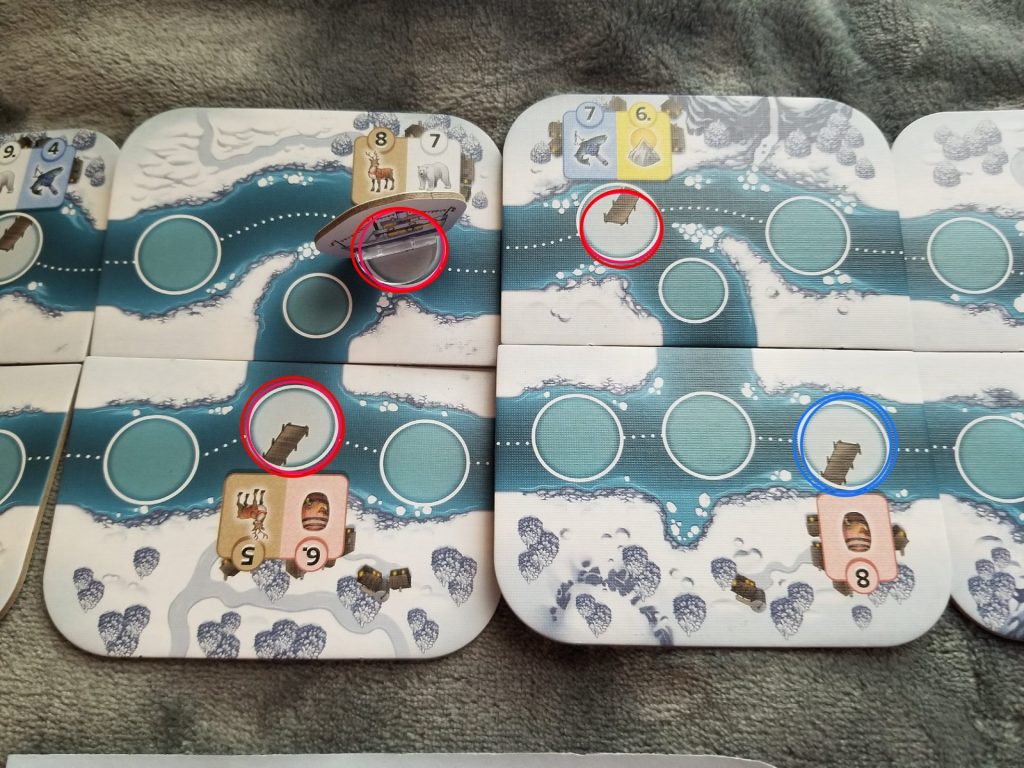Hello and welcome aboard the S.S. Meeple, I’m David and I’m going to be your captain. I hope you’re excited for your trip to the north! And what a trip it’s going to be. We’ve got a lot of great stuff lined up for you folks: reindeer watching, mountain climbing, and even some bar hopping just to name a few! I hope you brought your long johns, though, because it’s going to be cold.
In Riverside, the players are taking on the roles of tour guides competing to attract tourists to their guide boats for various arctic excursions. During each round players roll a handful of dice and will use their values to fill in their game sheets to trigger bonuses and earn victory points. And, as you have no doubt guessed, the player with the most victory points when the game comes to an end will win the game.
Chart
To set up a game of Riverside, first construct the course. Shuffle the ten River tiles and place them, back to back, in two rows of five with the rounded edges facing outwards. Then place the two end tiles at opposing sides of the river so the river is connected. Place the boat standee on the very first spot of the river. Then, tear off a sheet from the pad and hand one to each player along with a pencil. One player will receive all the dice and the Captain tile and you are ready to play.

Charter
At the beginning of each round of play, whoever is holding the Captain token (we’ll just call this person ‘The Captain’) will roll the six dice. The five non-green dice are sorted into numeric order and then the Captain will look at the third die. Any die that is of equal or lesser value than this die is placed beneath the Captain tile. Any die that is of higher value is placed above it. The green die is always placed above the Captain tile.

Now each player selects one of the dice and crosses off a number of empty squares (from left to right) on the boat matching the die color equal to the die’s value. If the die they select is one above the Captain tile, they must cross off one of the fire symbols on their player sheet per pip on the chosen die. If they select one of the ones beneath the Captain tile, they don’t need to do anything else. Players can optionally combine the value of the green die with the value of their selected die. If they choose to do so, they must fill in a fire symbol for each pip on the green die as well.
Filling in an entire row on a boat causes two things to happen. First, it will trigger a bonus allowing them to fill in circles on a different boat. Secondly, it will earn them a ticket, which is important for carrying out excursions (which we’ll get to in a moment). Simply check off the box for the ticket at the end of the completed row.

It is important to point out that a player is not required to complete a row on a ship before moving on to a different one. Players can work on several rows at a time if they choose to do so. In fact, there is a good reason a player may wish to do this (aside from trying to set themselves up to potentially trigger multiple bonuses at the same time in future turns): the Royals. On each ship are two pink circles representing royalty aboard the ship. Once each of these has been checked off, that ship’s special one-time power becomes available to the player. A couple of these are significant during the dice choosing phase allowing you to add +3 to the value of your selected die (yellow) or to utilize the green die without crossing off flame icons (blue). The others affect the way the player carries out excursions.
Chary
Going on excursions are where the glut of a player’s points will come from. After filling in boxes on their sheet, a player may go on a single excursion (two with the white boat’s power). The boat has a default range of three (six with the pink boat’s power), so the players will look at where the boat sits and count three hops away from the boat in any direction. Any of the colored locations that fall within that range can be visited with an excursion. Each player has the ability to extend their range by +1 a total of three times over the course of the game. For each +1 used, one of the circles is crossed off at the top of the sheet.
Determining the value of the excursion is easy. Simply note the color of the location and its number and then multiply that by the number of tickets that have been checked off for the matching colored boat (add an extra ticket with the brown boat’s power). Then write that value in the leftmost space for the excursions next to that boat on the sheet. Each new excursion, however, must have a higher value than any previous excursion.

For example, a player may decide to go on an excursion to the yellow 8 space. To determine the value of the excursion, they would count up the number of yellow tickets they have crossed off (let’s pretend they’ve crossed off two) and multiply that by 8 (for a total of 16). Then that total gets written into the leftmost excursion box on the yellow boat. If that total is not higher than any previous excursions taken to yellow locations, then the player must choose a different excursion instead.
Or a player may opt to not go on an excursion. That’s allowable, but not encouraged. In a game about scoring the most points, a turn spent scoring no points at all is a wasted turn.

At the very bottom of the player sheet is the Stave Church boat. This differs from the other boats in several ways. First, the value of each excursion to a stave church is determined by counting up the total of tickets from all of the other boats and then multiplying that by the value of the stave church. Secondly, they are scored differently. Which brings us to the end of the game.
Charisma
The goal of the game is to become the most revered boat captain and this is achieved by taking your guests on a bunch of really awesome, high scoring tours before the boat reaches the end of the river. Because once it does, the game is over and so is your cruise.
When the game ends, total up the points earned from the tickets and the excursions for each separate non-Stave boat (each boat will have its own grand total). Then add up the value of your Stave boat excursions and combine this total with the value of the lowest scoring boat from the other boats to arrive at your Captain point total. After comparing your Captain point total with the other players, if you have the highest, then you add fifteen points to your current Stave boat total. If you scored the lowest, you subtract fifteen points. If you’re somewhere in-between, nothing changes.
Write in your Stave boat total. Add this to the combined total of all of the other boats to arrive at your final score. If that score is higher than anyone else, you win the game.
Thoughts
Hadrian’s Wall is heavy in both game and physical weight and, for me, stands as a shining example of what the roll and write format is capable of. Ever since playing Hadrian’s Wall and subsequently falling deeply, madly in love with it, I have forgotten just how enjoyable a well-designed, mid-weight roll and write game can be. It’s easy to become so obsessed with something that you can’t see the forest for the trees, especially when the tree you’re fascinated with is the most amazing tree you’ve ever laid your eyes upon. But that doesn’t mean it’s the only tree. It just means your journey is on pause. There’s still plenty of forest left and lots of other trees yet to be seen.
This is just a clumsy metaphor to say that Riverside has grabbed my attention. A new tree that’s sprouted up in my periphery, it’s not as grandiose or magnificent as the arboreal agent in front of me, but there’s something about it that’s attractive all the same. It’s smaller in stature. Its leaves are a different color. Its branches are more well-defined as opposed to the intertwined maze of limbs and leaves of the lumbering giant in front of which I stand. It’s simple, and that simplistic charm calls to me.
Riverside doesn’t offer anything that I haven’t encountered before. My first foray into roll and writes (aside from staid industry giants like Yahtzee) was Ganz Schön Clever (GSC). The way that it comboed bonuses off of each other was mesmerizing and there was just something undeniably enjoyable about using the result from a single die to set off a mad box-filling frenzy. It’s that cascade of frenetic activity that draws me to the genre. Setting things up so that one thing plays off of another which then plays off of another returns me to my Magic: the Gathering roots. Riverside offers that same combo-tastic experience with much lower overhead.
Whereas GSC’s rules are semi-complex (each scoring area scores differently than the others and each has specific rules that dictate how it must be filled out), Riverside’s, by comparison, are much easier to wrap your head around. You only have to learn how one of the boats is filled in and scores in order to understand the greater part of the rest of the game.
That simplicity works in the game’s favor. I can get Riverside to the table, set up, taught, and played very quickly as a result. If I’d previously thought GSC was the perfect roll and write to nudge someone away from Yahtzee into the current era of gaming, I’d wager that Riverside is even more so. Not only is it easier to teach and play, but it has a theme. That helps seal the deal. People are much more apt to play a game about being a riverboat captain taking passengers on a cruise than they are to gravitate towards a game that doesn’t have a theme at all.
In fact, this game is so quick and approachable that it’s spent a great deal of time on my table over the past few weeks. My wife and I even played it together when we took our son to the park the other day. While he was busy running around and having a great time on the playground equipment, my wife and I were duking it out in the frozen tundra. Despite multiple interruptions (him taking power sips from his apple juice, depositing his Hot Wheels car on the table because he was tired of carrying it around, retrieving said car five seconds later, etc.), we were still able to knock out a complete game in under thirty minutes.
Riverside’s a very enjoyable game. Its small size, its portability, its rules-light gameplay, and its theme make it a perfect game for a date night or game days with friends. It straddles that line between easy and complex and it straddles it gracefully, a brain tickler more so than a brain burner. As such, it has found a welcome home on our game shelf.












Thanks for the review. Still had this shrink wrapped, so I will be encouraged to break it out this weekend.
What a good feeling it is to play a game you haven’t opened yet.
You won’t be sorry. It’s a really fun game.